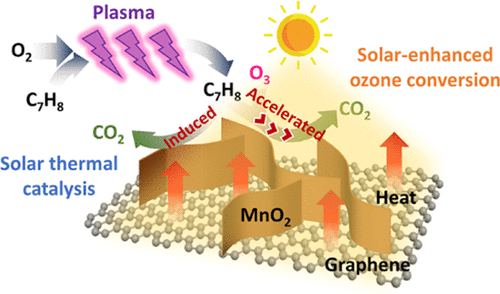当前位置:
X-MOL 学术
›
ACS Catal.
›
论文详情
Our official English website, www.x-mol.net, welcomes your
feedback! (Note: you will need to create a separate account there.)
Solar-Enhanced Plasma-Catalytic Oxidation of Toluene over a Bifunctional Graphene Fin Foam Decorated with Nanofin-like MnO2.
ACS Catalysis ( IF 11.3 ) Pub Date : 2020-03-25 , DOI: 10.1021/acscatal.9b04844 Zheng Bo 1 , Shiling Yang 1 , Jing Kong 1 , Jinhui Zhu 1 , Yaolin Wang 2 , Huachao Yang 1 , Xiaodong Li 1 , Jianhua Yan 1 , Kefa Cen 1 , Xin Tu 2
ACS Catalysis ( IF 11.3 ) Pub Date : 2020-03-25 , DOI: 10.1021/acscatal.9b04844 Zheng Bo 1 , Shiling Yang 1 , Jing Kong 1 , Jinhui Zhu 1 , Yaolin Wang 2 , Huachao Yang 1 , Xiaodong Li 1 , Jianhua Yan 1 , Kefa Cen 1 , Xin Tu 2
Affiliation

|
In this work, we propose a hybrid and unique process combining solar irradiation and post-plasma catalysis (PPC) for the effective oxidation of toluene over a highly active and stable MnO2/GFF (bifunctional graphene fin foam) catalyst. The bifunctional GFF, serving as both the catalyst support and light absorber, is decorated with MnO2 nanofins, forming a hierarchical fin-on-fin structure. The results show that the MnO2/GFF catalyst can effectively capture and convert renewable solar energy into heat (absorption of >95%), leading to a temperature rise (55.6 °C) of the catalyst bed under solar irradiation (1 sun, light intensity 1000 W m-2). The catalyst weight (9.8 mg) used in this work was significantly lower (10-100 times lower) than that used in previous studies (usually 100-1000 mg). Introducing solar energy into the typical PPC process via solar thermal conversion significantly enhances the conversion of toluene and CO2 selectivity by 36-63%, reaching ∼93% for toluene conversion and ∼83% for CO2 selectivity at a specific input energy of ∼350 J L-1, thus remarkably reducing the energy consumption of the plasma-catalytic gas cleaning process. The energy efficiency for toluene conversion in the solar-enhanced post-plasma catalytic (SEPPC) process reaches up to 12.7 g kWh-1, ∼57% higher than that using the PPC process without solar irradiation (8.1 g kWh-1), whereas the energy consumption of the SEPPC process is reduced by 35-52%. Moreover, the MnO2/GFF catalyst exhibits an excellent self-cleaning capability induced by solar irradiation, demonstrating a superior long-term catalytic stability of 72 h at 1 sun, significantly better than that reported in previous works. The prominent synergistic effect of solar irradiation and PPC with a synergistic capacity of ∼42% can be mainly attributed to the solar-induced thermal effect on the catalyst bed, boosting ozone decomposition (an almost triple enhancement from ∼0.18 gO3 g-1 h-1 for PPC to ∼0.52 gO3 g-1 h-1 for SEPPC) to generate more oxidative species (e.g., O radicals) and enhancing the catalytic oxidation on the catalyst surfaces, as well as the self-cleaning capacity of the catalyst at elevated temperatures driven by solar irradiation. This work opens a rational route to use abundant, renewable solar power to achieve high-performance and energy-efficient removal of volatile organic compounds.
中文翻译:

纳米鳍状MnO2修饰的双功能石墨鳍片泡沫对甲苯的太阳能增强等离子体催化氧化。
在这项工作中,我们提出了一种混合且独特的工艺,该工艺结合了太阳辐射和等离子体后催化(PPC),可在高活性和稳定的MnO2 / GFF(双功能石墨烯翅片泡沫)催化剂上有效地氧化甲苯。双功能GFF既用作催化剂载体,又用作光吸收剂,用MnO2纳米鳍装饰,形成分层的鳍上鳍结构。结果表明,MnO2 / GFF催化剂可以有效地捕获可再生的太阳能并将其转化为热量(吸收率> 95%),从而在太阳辐射(1个太阳,光照强度)下导致催化剂床的温度升高(55.6°C)。 1000 W m-2)。在这项工作中使用的催化剂重量(9.8毫克)比以前的研究中使用的催化剂重量(通常为100-1000毫克)要低得多(低10-100倍)。通过太阳热转化将太阳能引入典型的PPC工艺中,可显着提高甲苯和CO2选择性的转化率36-63%,在约350 J的特定输入能量下,甲苯转化率约为93%,CO2选择性约为83%。 L-1,因此显着降低了等离子体催化气体清洁过程的能耗。在太阳能增强的后等离子体催化(SEPPC)工艺中,甲苯转化的能量效率高达12.7 g kWh-1,比不使用太阳辐射的PPC工艺(8.1 g kWh-1)高约57%,而SEPPC工艺的能耗降低了35-52%。此外,MnO2 / GFF催化剂表现出优异的自辐照能力,该能力是由太阳辐射引起的,证明了其在1个太阳光下72小时的长期催化稳定性,明显优于以前的作品。太阳辐射和PPC具有约42%的协同能力的显着协同作用主要归因于太阳热对催化剂床层的热效应,从而促进了臭氧的分解(从约0.18 gO3 g-1 h-几乎增加了三倍) PPC为1到SEPPC为约0.52 gO3 g-1 h-1),以产生更多的氧化性物质(例如,O自由基)并增强催化剂表面的催化氧化作用,以及提高催化剂的自清洁能力太阳辐射驱动的温度。这项工作开辟了一条合理的途径,可以使用丰富的可再生太阳能来实现高性能和高能效去除挥发性有机化合物。太阳辐射和PPC具有约42%的协同能力的显着协同作用主要归因于太阳热对催化剂床层的热效应,促进了臭氧的分解(从约0.18 gO3 g-1 h-几乎增加了三倍) PPC为1到SEPPC为约0.52 gO3 g-1 h-1),以产生更多的氧化性物质(例如,O自由基)并增强催化剂表面的催化氧化作用,以及提高催化剂的自清洁能力太阳辐射驱动的温度。这项工作开辟了一条合理的途径,可以使用丰富的可再生太阳能来实现高性能和高能效去除挥发性有机化合物。太阳辐射和PPC具有约42%的协同能力的显着协同作用,主要归因于太阳热对催化剂床层的热效应,促进了臭氧的分解(从约0.18 gO3 g-1 h-几乎增加了三倍)。 PPC为1到SEPPC为约0.52 gO3 g-1 h-1),以产生更多的氧化性物质(例如,O自由基)并增强催化剂表面的催化氧化作用,以及提高催化剂的自清洁能力太阳辐射驱动的温度。这项工作开辟了一条合理的途径,可以使用丰富的可再生太阳能来实现高性能和高能效去除挥发性有机化合物。促进臭氧分解(从PPC的〜0.18 gO3 g-1 h-1到SEPPC的〜0.52 gO3 g-1 h-1几乎增加了三倍),以产生更多的氧化性物质(例如O自由基),并增强了对OPC的催化氧化作用。催化剂表面,以及由太阳辐射驱动的高温下催化剂的自清洁能力。这项工作开辟了一条合理的途径,可以使用丰富的可再生太阳能来实现高性能和高能效去除挥发性有机化合物。促进臭氧分解(从PPC的〜0.18 gO3 g-1 h-1到SEPPC的〜0.52 gO3 g-1 h-1几乎增加了三倍),以产生更多的氧化性物质(例如O自由基),并增强了对OPC的催化氧化作用。催化剂表面,以及由太阳辐射驱动的高温下催化剂的自清洁能力。这项工作开辟了一条合理的途径,可以使用丰富的可再生太阳能来实现高性能和高能效去除挥发性有机化合物。
更新日期:2020-03-26
中文翻译:

纳米鳍状MnO2修饰的双功能石墨鳍片泡沫对甲苯的太阳能增强等离子体催化氧化。
在这项工作中,我们提出了一种混合且独特的工艺,该工艺结合了太阳辐射和等离子体后催化(PPC),可在高活性和稳定的MnO2 / GFF(双功能石墨烯翅片泡沫)催化剂上有效地氧化甲苯。双功能GFF既用作催化剂载体,又用作光吸收剂,用MnO2纳米鳍装饰,形成分层的鳍上鳍结构。结果表明,MnO2 / GFF催化剂可以有效地捕获可再生的太阳能并将其转化为热量(吸收率> 95%),从而在太阳辐射(1个太阳,光照强度)下导致催化剂床的温度升高(55.6°C)。 1000 W m-2)。在这项工作中使用的催化剂重量(9.8毫克)比以前的研究中使用的催化剂重量(通常为100-1000毫克)要低得多(低10-100倍)。通过太阳热转化将太阳能引入典型的PPC工艺中,可显着提高甲苯和CO2选择性的转化率36-63%,在约350 J的特定输入能量下,甲苯转化率约为93%,CO2选择性约为83%。 L-1,因此显着降低了等离子体催化气体清洁过程的能耗。在太阳能增强的后等离子体催化(SEPPC)工艺中,甲苯转化的能量效率高达12.7 g kWh-1,比不使用太阳辐射的PPC工艺(8.1 g kWh-1)高约57%,而SEPPC工艺的能耗降低了35-52%。此外,MnO2 / GFF催化剂表现出优异的自辐照能力,该能力是由太阳辐射引起的,证明了其在1个太阳光下72小时的长期催化稳定性,明显优于以前的作品。太阳辐射和PPC具有约42%的协同能力的显着协同作用主要归因于太阳热对催化剂床层的热效应,从而促进了臭氧的分解(从约0.18 gO3 g-1 h-几乎增加了三倍) PPC为1到SEPPC为约0.52 gO3 g-1 h-1),以产生更多的氧化性物质(例如,O自由基)并增强催化剂表面的催化氧化作用,以及提高催化剂的自清洁能力太阳辐射驱动的温度。这项工作开辟了一条合理的途径,可以使用丰富的可再生太阳能来实现高性能和高能效去除挥发性有机化合物。太阳辐射和PPC具有约42%的协同能力的显着协同作用主要归因于太阳热对催化剂床层的热效应,促进了臭氧的分解(从约0.18 gO3 g-1 h-几乎增加了三倍) PPC为1到SEPPC为约0.52 gO3 g-1 h-1),以产生更多的氧化性物质(例如,O自由基)并增强催化剂表面的催化氧化作用,以及提高催化剂的自清洁能力太阳辐射驱动的温度。这项工作开辟了一条合理的途径,可以使用丰富的可再生太阳能来实现高性能和高能效去除挥发性有机化合物。太阳辐射和PPC具有约42%的协同能力的显着协同作用,主要归因于太阳热对催化剂床层的热效应,促进了臭氧的分解(从约0.18 gO3 g-1 h-几乎增加了三倍)。 PPC为1到SEPPC为约0.52 gO3 g-1 h-1),以产生更多的氧化性物质(例如,O自由基)并增强催化剂表面的催化氧化作用,以及提高催化剂的自清洁能力太阳辐射驱动的温度。这项工作开辟了一条合理的途径,可以使用丰富的可再生太阳能来实现高性能和高能效去除挥发性有机化合物。促进臭氧分解(从PPC的〜0.18 gO3 g-1 h-1到SEPPC的〜0.52 gO3 g-1 h-1几乎增加了三倍),以产生更多的氧化性物质(例如O自由基),并增强了对OPC的催化氧化作用。催化剂表面,以及由太阳辐射驱动的高温下催化剂的自清洁能力。这项工作开辟了一条合理的途径,可以使用丰富的可再生太阳能来实现高性能和高能效去除挥发性有机化合物。促进臭氧分解(从PPC的〜0.18 gO3 g-1 h-1到SEPPC的〜0.52 gO3 g-1 h-1几乎增加了三倍),以产生更多的氧化性物质(例如O自由基),并增强了对OPC的催化氧化作用。催化剂表面,以及由太阳辐射驱动的高温下催化剂的自清洁能力。这项工作开辟了一条合理的途径,可以使用丰富的可再生太阳能来实现高性能和高能效去除挥发性有机化合物。











































 京公网安备 11010802027423号
京公网安备 11010802027423号